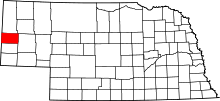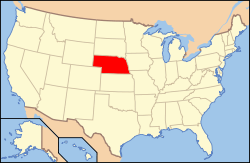Scotts Bluff County, Nebraska
| Scotts Bluff County, Nebraska | |
|---|---|
|
Scotts Bluff County Courthouse in Gering | |
 Location in the U.S. state of Nebraska | |
 Nebraska's location in the U.S. | |
| Founded | 1888 |
| Seat | Gering |
| Largest city | Scottsbluff |
| Area | |
| • Total | 745 sq mi (1,930 km2) |
| • Land | 739 sq mi (1,914 km2) |
| • Water | 6.0 sq mi (16 km2), 0.8% |
| Population | |
| • (2010) | 36,970 |
| • Density | 50/sq mi (19/km²) |
| Congressional district | 3rd |
| Time zone | Mountain: UTC-7/-6 |
| Website |
www |
Scotts Bluff County is a county on the western border of the U.S. state of Nebraska. As of the 2010 census, the population was 36,970.[1] Its county seat is Gering,[2] and its largest city is Scottsbluff.
Scotts Bluff County is included in the Scottsbluff, NE Micropolitan Statistical Area.
In the Nebraska license plate system, Scotts Bluff County is represented by the prefix 21, since the county had the twenty-first-largest number of registered vehicles registered when the state's license-plate system was established in 1922.
History
The county is named after a prominent bluff that served as a landmark for 19th-century pioneers traveling along the Oregon Trail. Scotts Bluff was named after Hiram Scott, a Rocky Mountain Fur Company trapper who died nearby around 1828.[3] Washington Irving claimed after being injured and abandoned Scott had crawled sixty miles only to perish near the bluff that now bears his name.[4] The bluff is now managed by the National Park Service as Scotts Bluff National Monument.
The town of Gering was founded at the base of the bluff in 1887, and the city of Scottsbluff was founded across the North Platte River in 1900. Joined by the river, the former transportation highway, the two cities now form Nebraska's 7th-largest urban area.
Transportation
Scotts Bluff County Airport (BFF) is Nebraska's third-busiest airport in terms of passenger boardings.
Geography
According to the U.S. Census Bureau, the county has an area of 745 square miles (1,930 km2), of which 739 square miles (1,910 km2) is land and 6.0 square miles (16 km2) (0.8%) is water.[5]

Major highways
Adjacent counties
- Sioux County (north)
- Box Butte County (northeast)
- Morrill County (east)
- Banner County (south)
- Goshen County, Wyoming (west)
National protected area
Demographics
| Historical population | |||
|---|---|---|---|
| Census | Pop. | %± | |
| 1890 | 1,888 | — | |
| 1900 | 2,552 | 35.2% | |
| 1910 | 8,355 | 227.4% | |
| 1920 | 20,710 | 147.9% | |
| 1930 | 28,644 | 38.3% | |
| 1940 | 33,917 | 18.4% | |
| 1950 | 33,939 | 0.1% | |
| 1960 | 33,809 | −0.4% | |
| 1970 | 36,432 | 7.8% | |
| 1980 | 38,344 | 5.2% | |
| 1990 | 36,025 | −6.0% | |
| 2000 | 36,951 | 2.6% | |
| 2010 | 36,970 | 0.1% | |
| Est. 2015 | 36,261 | [6] | −1.9% |
| U.S. Decennial Census[7] 1790-1960[8] 1900-1990[9] 1990-2000[10] 2010-2013[1] | |||
As of the census[11] of 2000, there were 36,951 people, 14,887 households, and 10,167 families residing in the county. The population density was 50 people per square mile (19/km²). There were 16,119 housing units at an average density of 22 per square mile (8/km²). The racial makeup of the county was 87.58% White, 0.27% Black or African American, 1.88% Native American, 0.57% Asian, 0.04% Pacific Islander, 8.02% from other races, and 1.63% from two or more races. 17.19% of the population were Hispanic or Latino of any race. 39.5% were of German, 8.6% English and 6.8% Irish ancestry according to Census 2000.
There were 14,887 households out of which 31.50% had children under the age of 18 living with them, 54.20% were married couples living together, 10.70% had a female householder with no husband present, and 31.70% were non-families. 27.80% of all households were made up of individuals and 12.80% had someone living alone who was 65 years of age or older. The average household size was 2.44 and the average family size was 2.97.
In the county the population was spread out with 25.90% under the age of 18, 8.40% from 18 to 24, 25.40% from 25 to 44, 23.00% from 45 to 64, and 17.20% who were 65 years of age or older. The median age was 38 years. For every 100 females there were 91.20 males. For every 100 females age 18 and over, there were 88.30 males.
The median income for a household in the county was $32,016, and the median income for a family was $38,932. Males had a median income of $30,317 versus $20,717 for females. The per capita income for the county was $17,355. About 11.00% of families and 14.50% of the population were below the poverty line, including 22.00% of those under age 18 and 8.70% of those age 65 or over.
Economy
The economy of Scotts Bluff County is based on agriculture, with the primary crops being sugar beets, corn, and beans.
Communities
Cities
- Gering (county seat)
- Minatare
- Mitchell
- Scottsbluff
Villages
Unincorporated communities
See also
- Lake Minatare Lighthouse
- National Register of Historic Places listings in Scotts Bluff County, Nebraska
References
- 1 2 "State & County QuickFacts". United States Census Bureau. Retrieved September 22, 2013.
- ↑ "Find a County". National Association of Counties. Retrieved 2011-06-07.
- ↑ "The Life and Legend of Hiram Scott". National Park Service. Retrieved 29 January 2015.
- ↑ Washington, Irving (1837). The Adventures of Captain Bonneville. Retrieved 29 January 2015.
- ↑ "2010 Census Gazetteer Files". United States Census Bureau. August 22, 2012. Retrieved December 11, 2014.
- ↑ "County Totals Dataset: Population, Population Change and Estimated Components of Population Change: April 1, 2010 to July 1, 2015". Retrieved July 2, 2016.
- ↑ "U.S. Decennial Census". United States Census Bureau. Retrieved December 11, 2014.
- ↑ "Historical Census Browser". University of Virginia Library. Retrieved December 11, 2014.
- ↑ "Population of Counties by Decennial Census: 1900 to 1990". United States Census Bureau. Retrieved December 11, 2014.
- ↑ "Census 2000 PHC-T-4. Ranking Tables for Counties: 1990 and 2000" (PDF). United States Census Bureau. Retrieved December 11, 2014.
- ↑ "American FactFinder". United States Census Bureau. Retrieved 2008-01-31.
 |
Sioux County | Box Butte County |  | |
| Goshen County, Wyoming | |
Morrill County | ||
| ||||
| | ||||
| Banner County |
Coordinates: 41°51′N 103°43′W / 41.85°N 103.71°W